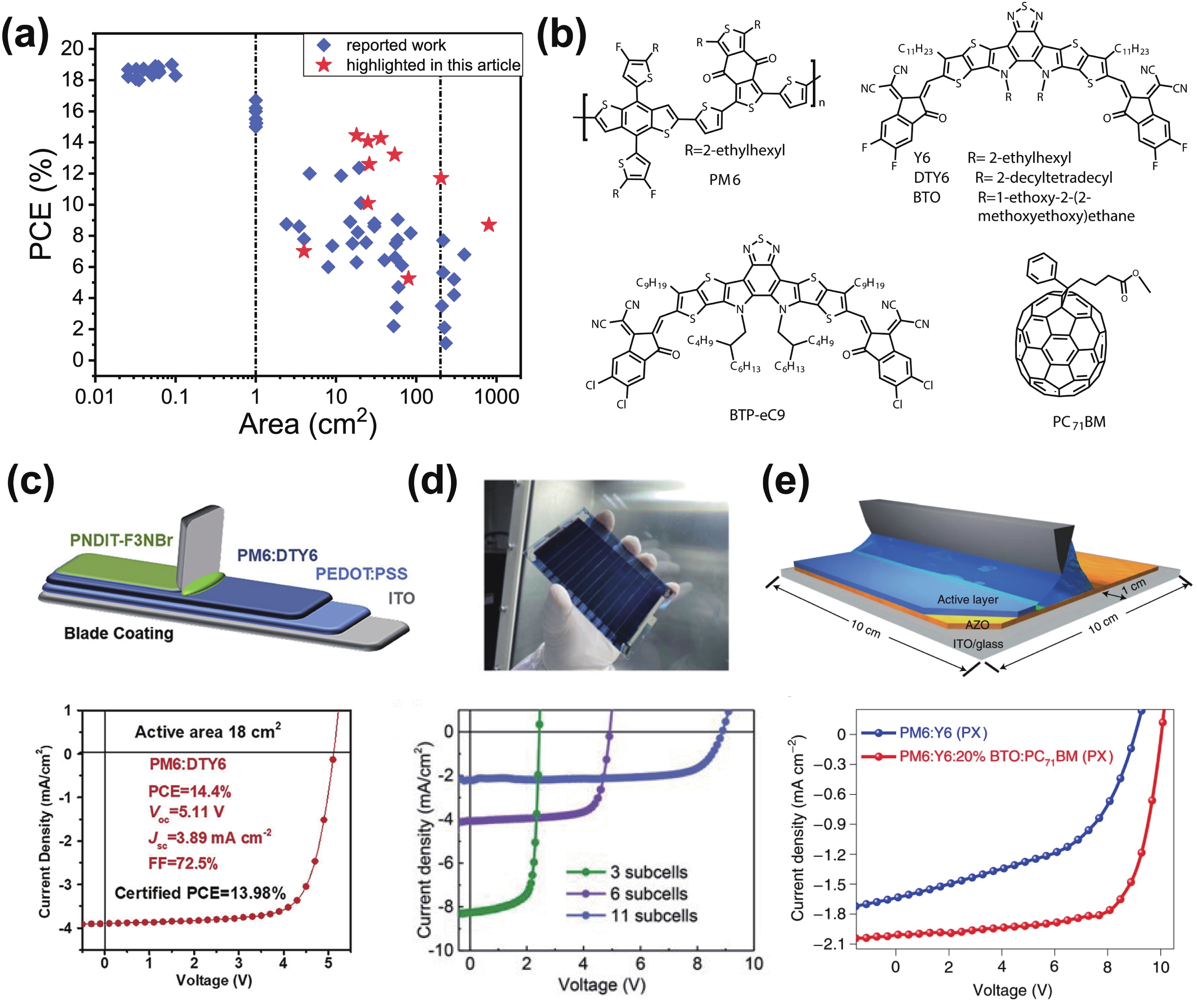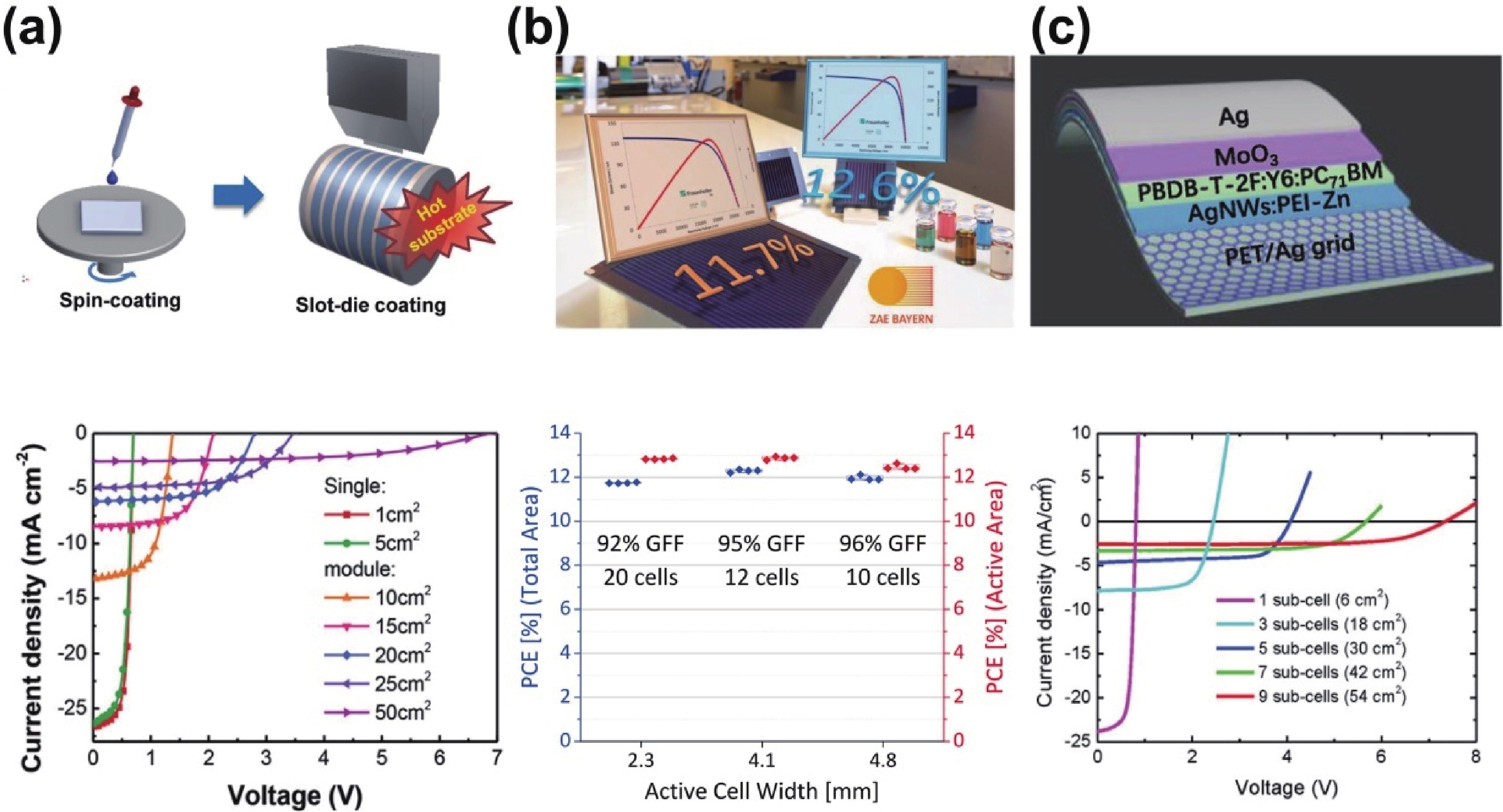| Citation: |
Min Li, Jilin Wang, Liming Ding, Xiaoyan Du. Large-area organic solar cells[J]. Journal of Semiconductors, 2022, 43(6): 060201. doi: 10.1088/1674-4926/43/6/060201
****
M Li, J L Wang, L M Ding, X Y Du. Large-area organic solar cells[J]. J. Semicond, 2022, 43(6): 060201. doi: 10.1088/1674-4926/43/6/060201
|
-
References
[1] Tong Y, Xiao Z, Du X, et al. Progress of the key materials for organic solar cells. Sci China Chem, 2020, 63, 758 doi: 10.1007/s11426-020-9726-0[2] Duan C, Ding L. The new era for organic solar cells: Non-fullerene small molecular acceptors. Sci Bull, 2020, 65, 1231 doi: 10.1016/j.scib.2020.04.030[3] Cao J, Yi L, Ding L. The origin and evolution of Y6 structure. J Semicond, 2022, 43, 030202 doi: 10.1088/1674-4926/43/3/030202[4] Liu Q, Jiang Y, Jin K, et al. 18% efficiency organic solar cells. Sci Bull, 2020, 65, 272 doi: 10.1016/j.scib.2020.01.001[5] Qin J, Zhang L, Zuo C, et al. A chlorinated copolymer donor demonstrates a 18.13% power conversion efficiency. J Semicond, 2021, 42, 010501 doi: 10.1088/1674-4926/42/1/010501[6] Jin K, Ou Z, Lixiu Z, et al. A chlorinated lactone polymer donor featuring high performance and low cost. J Semicond, 2022, 43, 050501 doi: 10.1088/1674-4926/43/5/050501[7] Guan W, Yuan D, Wu J, et al. Blade-coated organic solar cells from non-halogenated solvent offer 17% efficiency. J Semicond, 2021, 42, 030502 doi: 10.1088/1674-4926/42/3/030502[8] Cui Y, Xu Y, Yao H, et al. Single-junction organic photovoltaic cell with 19% efficiency. Adv Mater, 2021, 33, 2102420 doi: 10.1002/adma.202102420[9] Jin K, Xiao Z, Ding L. 18.69% power conversion efficiency from organic solar cells. J Semicond, 2021, 42, 060502 doi: 10.1088/1674-4926/42/6/060502[10] Jin K, Xiao Z, Ding L. D18, an eximious solar polymer!. J Semicond, 2021, 42, 010502 doi: 10.1088/1674-4926/42/1/010502[11] Meng X, Jin K, Xiao Z, et al. Side chain engineering on D18 polymers yields 18.74% power conversion efficiency. J Semicond, 2021, 42, 100501 doi: 10.1088/1674-4926/42/10/100501[12] Brabec C J, Distler A, Du X, et al. Material strategies to accelerate OPV technology toward a GW technology. Adv Energy Mater, 2020, 10, 2001864 doi: 10.1002/aenm.202001864[13] NREL, Best research-cell efficiency chart, https://www.nrel.gov/pv/cell-efficiency.html (accessed: December 2021)[14] Dong S, Jia T, Zhang K, et al. Single-component non-halogen solvent-processed high-performance organic solar cell module with efficiency over 14%. Joule, 2020, 4, 2004 doi: 10.1016/j.joule.2020.07.028[15] Dong X, Jiang Y, Sun L, et al. Large-area organic solar modules with efficiency over 14%. Adv Funct Mater, 2021, 2110209 doi: 10.1002/adfm.202110209[16] Chen H, Zhang R, Chen X, et al. A guest-assisted molecular-organization approach for >17% efficiency organic solar cells using environmentally friendly solvents. Nat Energy, 2021, 6, 1045 doi: 10.1038/s41560-021-00923-5[17] Park S, Kim T, Yoon S, et al. Progress in materials, solution processes, and long-term stability for large-area organic photovoltaics. Adv Mater, 2020, 32, 2002217 doi: 10.1002/adma.202002217[18] Wang G, Adil M A, Zhang J, et al. Large-area organic solar cells: Material requirements, modular designs, and printing methods. Adv Mater, 2019, 31, 1805089 doi: 10.1002/adma.201805089[19] Wang G, Zhang J, Yang C, et al. Synergistic optimization enables large-area flexible organic solar cells to maintain over 98% PCE of the small-area rigid devices. Adv Mater, 2020, 32, 2005153 doi: 10.1002/adma.202005153[20] Zhang Y, Liu K, Huang J, et al. Graded bulk-heterojunction enables 17% binary organic solar cells via nonhalogenated open air coating. Nat Commun, 2021, 12, 4815 doi: 10.1038/s41467-021-25148-8[21] Distler A, Brabec C J, Egelhaaf H J. Organic photovoltaic modules with new world record efficiencies. Prog Photovolt Res Appl, 2020, 29, 24 doi: 10.1002/pip.3336[22] Pan W, Han Y, Wang Z, et al. Over 1 cm2 flexible organic solar cells. J Semicond, 2021, 42, 050301 doi: 10.1088/1674-4926/42/5/050301[23] Qin F, Sun L, Chen H, et al. 54 cm2 large-area flexible organic solar modules with efficiency above 13%. Adv Mater, 2021, 33, 2103017 doi: 10.1002/adma.202103017[24] Han Y W, Jeon S J, Lee H S, et al. Evaporation-free nonfullerene flexible organic solar cell modules manufactured by an all-solution process. Adv Energy Mater, 2019, 9, 1902065 doi: 10.1002/aenm.201902065[25] Tam K C, Saito H, Maisch P, et al. Highly reflective and low resistive top electrode for organic solar cells and modules by low temperature silver nanoparticle ink. Sol RRL, 2021, 6, 2100887 doi: 10.1002/solr.202100887[26] Cui Y, Yao H, Hong L, et al. Organic photovoltaic cell with 17% efficiency and superior processability. Natl Sci Rev, 2020, 7, 1239 doi: 10.1093/nsr/nwz200[27] An K, Peng F, Zhong W, et al. Improving photovoltaic parameters of all-polymer solar cells through integrating two polymeric donors. Sci China Chem, 2021, 64, 2010 doi: 10.1007/s11426-021-1078-5[28] Liu X, Zheng Z, Wang J, et al. Fluidic manipulating of printable zinc oxide for flexible organic solar cells. Adv Mater, 2021, 34, 2106453 doi: 10.1002/adma.202106453[29] Cui Y, Yao H, Zhang J, et al. Single-junction organic photovoltaic cells with approaching 18% efficiency. Adv Mater, 2020, 32, 1908205 doi: 10.1002/adma.201908205[30] Würfel U, Herterich J, List M, et al. A 1 cm2 organic solar cell with 15.2% certified efficiency: Detailed characterization and identification of optimization potential. Sol RRL, 2021, 5, 2000802 doi: 10.1002/solr.202000802[31] Han Y, Chen X, Wei J, et al. Efficiency above 12% for 1 cm2 flexible organic solar cells with Ag/Cu grid transparent conducting electrode. Adv Sci, 2019, 6, 1901490 doi: 10.1002/advs.201901490[32] Sun R, Wu Q, Guo J, et al. A layer-by-layer architecture for printable organic solar cells overcoming the scaling lag of module efficiency. Joule, 2020, 4, 407 doi: 10.1016/j.joule.2019.12.004[33] Meng X, Zhang L, Xie Y, et al. A general approach for lab-to-manufacturing translation on flexible organic solar cells. Adv Mater, 2019, 31, 1903649 doi: 10.1002/adma.201903649[34] Zhang K, Chen Z, Armin A, et al. Efficient large area organic solar cells processed by blade-coating with single-component green solvent. Sol RRL, 2018, 2, 1700169 doi: 10.1002/solr.201700169[35] Mao L, Luo B, Sun L, et al. Writable and patternable organic solar cells and modules inspired by an old chinese calligraphy tradition. Mater Horizons, 2018, 5, 123 doi: 10.1039/C7MH00559H[36] Jeong J H, Jahandar M, Prasetio A, et al. Multi-dimensional interfacial engineering for a practical large-area transparent flexible organic photovoltaics. Chem Eng J, 2021, 419, 129672 doi: 10.1016/j.cej.2021.129672[37] Jia Z, Chen Z, Chen X, et al. 19.34 cm2 large-area quaternary organic photovoltaic module with 12.36% certified efficiency. Photonics Res, 2021, 9, 324 doi: 10.1364/PRJ.416229[38] Liao C Y, Chen Y, Lee C C, et al. Processing strategies for an organic photovoltaic module with over 10% efficiency. Joule, 2020, 4, 189 doi: 10.1016/j.joule.2019.11.006[39] Chang Y M, Liao C Y, Lee C C, et al. All solution and ambient processable organic photovoltaic modules fabricated by slot-die coating and achieved a certified 7.56% power conversion efficiency. Sol Energy Mater Sol Cells, 2019, 202, 110064 doi: 10.1016/j.solmat.2019.110064[40] Lee J, Seo Y H, Kwon S N, et al. Slot-die and roll-to-roll processed single junction organic photovoltaic cells with the highest efficiency. Adv Energy Mater, 2019, 9, 1901805 doi: 10.1002/aenm.201901805[41] Han Y W, Lee H S, Moon D K. Printable and semitransparent nonfullerene organic solar modules over 30 cm2 introducing an energy-level controllable hole transport layer. ACS Appl Mater Interfaces, 2021, 13, 19085 doi: 10.1021/acsami.1c01021[42] Mao L, Sun L, Luo B, et al. Patching defects in the active layer of large-area organic solar cells. J Mater Chem A, 2018, 6, 5817 doi: 10.1039/C7TA11264E[43] Rasool S, Vu D V, Song C E, et al. Room temperature processed highly efficient large-area polymer solar cells achieved with molecular engineering of copolymers. Adv Energy Mater, 2019, 9, 1900168 doi: 10.1002/aenm.201900168[44] Apilo P, Välimäki M, Po R, et al. Fully roll-to-roll printed P3HT/indene-C60-bisadduct modules with high open-circuit voltage and efficiency. Sol RRL, 2018, 2, 1700160 doi: 10.1002/solr.201700160[45] Park S H, Park S, Lee S, et al. Developement of highly efficient large area organic photovoltaic module: Effects of nonfullerene acceptor. Nano Energy, 2020, 77, 105147 doi: 10.1016/j.nanoen.2020.105147[46] Park S H, Park S, Kurniawan D, et al. Highly efficient large-area organic photovoltaic module with a 350 nm thick active layer using a random terpolymer donor. Chem Mater, 2020, 32, 3469 doi: 10.1021/acs.chemmater.9b05399[47] Strohm S, Machui F, Langner S, et al. P3HT: Non-fullerene acceptor based large area, semi-transparent PV modules with power conversion efficiencies of 5%, processed by industrially scalable methods. Energy Environ Sci, 2018, 11, 2225 doi: 10.1039/C8EE01150H[48] Ibraikulov O A, Wang J, Kamatham N, et al. ITO-free organic photovoltaic modules based on fluorinated polymers deposited from non-halogenated solution: A major step toward large-scale module production. Sol RRL, 2019, 3, 1900273 doi: 10.1002/solr.201900273[49] Wang D, Zhou G, Li Y, et al. High-performance organic solar cells from non-halogenated solvents. Adv Funct Mater, 2021, 32, 2107827 doi: 10.1002/adfm.202107827[50] Huang K M, Wong Y Q, Lin M C, et al. Highly efficient and stable organic solar cell modules processed by blade coating with 5.6% module efficiency and active area of 216 cm2. Prog Photovolt, 2019, 27, 264 doi: 10.1002/pip.3078[51] Huang K M, Lin C M, Chen S H, et al. Nonfullerene polymer solar cell with large active area of 216 cm2 and high power conversion efficiency of 7.7%. Sol RRL, 2019, 3, 1900071 doi: 10.1002/solr.201900071 -
Proportional views






 DownLoad:
DownLoad:















